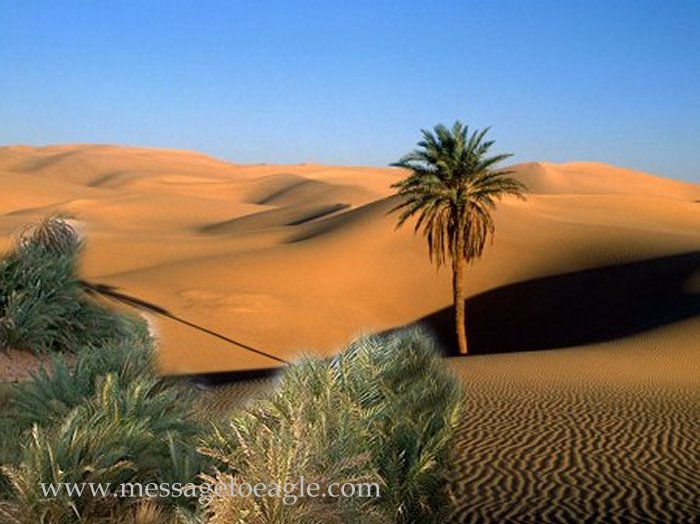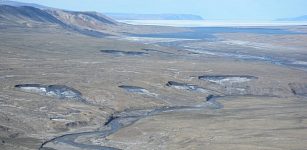What Changed The Green Sahara Into A Desert?
Ellen Lloyd – MessageToEagle.com – The Sahara, which is the world’s largest desert covers one third of the African continent. In ancient times, some thousand years ago, this vast area was fertile grassland.
Then something happened and the Green Sahara turned into a desert.
Today there is enough evidence to show that the Sahara desert had once a grassland ecosystem and was a much wetter place than it is today.
So, what caused this major climate change?
Most scientists believe the Sahara dried up due to a change in the Earth’s orbit, which affects solar insolation, or the amount of electromagnetic energy the Earth receives from the Sun. Or to use simpler words, insolation refers to the amount of sunlight shining down on a particular area at a certain time. It depends on factors such as the geographic location, time of day, season, landscape and local weather.
Climate scientist Gavin Schmidt, of NASA’s Goddard Institute for Space Studies, explained that around 8,000 years ago, the Earth’s orbit was slightly different to how it is today. The tilt changed from around 24.1 degrees to the present-day 23.5 degrees.
“Additionally, the Earth had its closest approach to the Sun in the northern hemisphere (with) summer in August,” Schmidt said.
“Today, that closest approach is in January. So, summertime in the north was warmer back then than it is now.”

The changes in the Earth’s orbital tilt and precession (or the wobbling motion) occur because of gravitational forces emanating from other bodies in the solar system.
To understand exactly what happens, picture a spinning top when it is slightly disturbed. Just like a top, the Earth too wobbles slightly about its rotational axis. This tilt changes between roughly 22 and 25 degrees about every 41,000 years, while the precession varies on about a 26,000-year period. These cycles have been determined by astronomers and validated by geologists studying ocean sediment records.
“If you get a long enough time series that can be well-dated, you should be able to see frequencies in the data that correspond to the periods predicted by theory,” Schmidt explained.
Although scientists agree that the Sahara was once a green place, it is still widely debated how the transition occurred.
Due to the lack of paleo-environmental records, scientists must often resort to climate modeling.
In 1999, a group of German scientists used computer simulation to create a model of the Earth’s climate thousands of years ago. They concluded that the climatic transition of the Sahara took place abruptly, within a possible span of about 300 years.
There are however other scientists who disagree with those calculations. New evidence show that the eastern region of the Sahara desert, especially the area near Lake Yoa in Chad, dried up slowly and progressively since the mid-Holocene period.
“The findings of this study are that the sedimentological and geochemical properties of the lake sediments confirm that the Sahara has been drying slowly from six thousand years ago to reach the present day conditions around 1,100 years ago,” said Pierre Francus, professor at the National Institute of Scientific Research in Quebec, Canada.
Gavin Schmidt belongs to the group of scientists who think there is enough evidence fro sudden changes in the Sahara.
“Given the very strong dependence of vegetation on water availability, the end of the ‘Green Sahara’ came about quite suddenly around 5,500 years ago,” Schmidt said. “Thus, a very slow change in the orbit (led) to an abrupt collapse in that ecosystem.”
The Sahara is a vast area and we should not dismiss the possibility that parts of the land dried up abruptly while it took other regions a longer period of time to transform into a desert.
“It seems that drying was progressive in our area, but it does not automatically mean that it was the case in other areas such as Western Sahara,” said Francus. “We cannot rule out completely the possibility of abrupt drying. Understanding the regional differences in climate change is the next challenge for climate scientists.”
As an example, Francus mentions the Younger Dryas where an abrupt climate change took place between 12,800 and 11,500 years ago.
According to the National Oceanic and Atmospheric Administration, the end of this period was particularly abrupt when, for example, in Greenland, temperatures increased 18 degrees Fahrenheit in about a decade.
“Many scientists think that abrupt climate changes are possible in the future, but the nature, direction and intensity of these changes will most probably be region-dependent,” Francus said.
Francus also noted that there are some models that cannot predict an abrupt climate shift at all. Some scientists feel that there is not enough knowledge to understand the processes driving these changes primarily because it is difficult to model the soil moisture and cover.
See also:
Controversial Theory Suggests Humans Turned Sahara Into A Desert
Earth’s Magnetic Poles Aren’t About To Switch, Researchers Say
‘Frozen Ark’ To Preserve DNA Of Species In Face Of The Sixth Mass Extinction On Earth
Scientists Now Know Why The Climate Underwent Dramatic Changes At The End Of The Last Ice Age
For the time being it remains unclear how long it took before the entire Sahara turned into a desert.
The Sahara could have dried up gradually or suddenly.
What we do know is that the world’s largest desert was only some thousand years ago a green flourishing place. By understanding how the climate changed in the past and what kinds of natural forces affected those changes, it is possible to determine the precise role human behavior plays on current climate change.
“The models that are used to predict future climate need to be tested, and using information from the past is one way to achieve this goal,” Francus said.
Scientists at NASA estimate Earth’s axial tilt changes at a rate of approximately 2.6 centimeters each year. Changes in the Earth’s orbital tilt affect the weather and our climate.
Maybe one day in the future the Sahara will once again be fertile grassland.
First version of this article was originally published on May 29, 2012
Written by Ellen Lloyd – MessageToEagle.com
Copyright © MessageToEagle.com This material may not be published, broadcast, rewritten or redistributed in whole or part without the express written permission of MessageToEagle.com
References:
National Institute of Scientific Research











